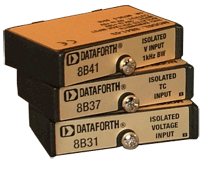DATAQ Instruments sells an amplifier into applications that require frequency measurements in the range of 500 Hz to 100 kHz full scale. The model is DI-8B45, and it’s sold with different suffix numbers that each defines a fixed full scale range in Hz or kHz. The amplifier is useful when the frequency of a signal (as opposed to its amplitude) carries information, like rpm and flow. The DI-8B45 is essentially an integration amplifier, so that the more frequently the amplifier’s input experiences a pulse from the signal source, the higher its output voltage. Hence, a relationship is established between rate on the input and DC volts on the output. The output can be sampled at relatively low rates and still yield an accurate measurement of the applied frequency. Sounds great, right? Ah, but there’s a potential problem.
Since the DI-8B45 is an integrator module, frequency measurements all the way down to DC are not possible. There will be a level where the time constants built into the amplifier collide with lower frequencies, generating ripple in the output that will eventually render useful measurements impossible. That threshold is different from application to application, but you can apply a spec defined in the DI-8B45’s data sheet to provide a quantitative measure for ripple value in Hz. Find the spec called:
Noise, Output Ripple: <10mVp-p at Input >2% Span
A bit cryptic, right? No problem, I’ll decode it for you. We’ll begin by restating the spec for clarity:
Output ripple will be less than 10 mV peak-to-peak for applied frequencies greater than 2% of span.
That’s a little better, but what does it mean? Lets use an example of the most popular version of the DI-8B45 amplifier, model DI-8B45-01, that has a 500 Hz full scale input range, and an output range of 5 VFS. If you apply a 500 Hz frequency to this amplifier, its output will go to 5 V. If you apply 250 Hz, the output will go to 2.5 V, and so on. However, the above ripple specification states that you cannot apply this linear relationship all the way to zero Hz on the input and zero volts on the output. Let’s see why.
Span for the 8B45-01 amplifier is 500 Hz, so 2% of span is 10 Hz. At this level of applied frequency we should expect an amplifier output equal to 100 mV (10 Hz ÷ 500 Hz x 5 V), ±10 mV. That ±10 mV qualifier translates to ±1 Hz (10 mV ÷ 5V x 500 Hz) of ripple in calibrated units on the output, so the inaccuracy of our measurement is ±1 Hz with 10 Hz applied. And as the spec leaves us to believe, this ripple will become worse and worse as input frequency declines below 10 Hz toward 0 Hz. How bad it will get is unpredictable because it’s a function of applied signal duty cycle and other parameters outside the control of the amplifier. So you probably should not plan on much measurement accuracy at frequencies less than 2% of full scale for all versions of the DI-8B45.
One way to stack the odds in your favor in low frequency applications is to increase the number of pulses per revolution whenever possible. This means adding more reflective strips when using optical, or more magnets when using magnetic detection methods. A shaft revolving at 100 rpm with one pulse per revolution generates a 1.7 Hz output frequency. Adding nine more reflective strips or magnets increases measurement frequency to over 16 Hz and might make the difference between a good or bad rpm measurement.


 View Cart
View Cart sales@dataq.com
sales@dataq.com 330-668-1444
330-668-1444